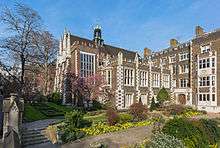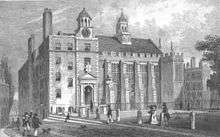Middle Temple


The Honourable Society of the Middle Temple, commonly known simply as Middle Temple, is one of the four Inns of Court exclusively entitled to call their members to the English Bar as barristers, the others being the Inner Temple, Gray's Inn and Lincoln's Inn. It is located in the wider Temple area of London, near the Royal Courts of Justice, and within the City of London.
History


In the 13th century, the Inns of Court originated as hostels and schools for student lawyers. The Middle Temple is the western part of "The Temple", the headquarters of the Knights Templar until they were dissolved in 1312. The Temple Church still stands as a "peculiar" (extra-diocesan) church of the Inner and Middle Temples.
The Inns stopped being responsible for legal education in 1852, although they continue to provide training in areas such as advocacy and ethics for students, pupil barristers and newly qualified barristers. Most of the Inn is occupied by barristers' offices, known as chambers. One of the Middle Temple's main functions now is to provide education and support for new members to the profession. This is done through advocacy training, the provision of scholarships (over £1 million in 2011), subsidised accommodation both in the Temple and in Clapham,[1] and by providing events where junior members may meet senior colleagues for help and advice.
The Inn

Middle Temple Hall is at the heart of the Inn, and the Inn's student members are required to attend a minimum of 12 qualifying sessions there. Qualifying sessions, formerly known as "dinners", combine collegiate and educational elements and will usually combine a dinner or reception with lectures, debates, mooting, or musical performances.
Middle Temple Hall is also a popular venue for banqueting, weddings, receptions and parties. In recent years, it has become a much-used film location—the cobbled streets, historic buildings and gas lighting give it a unique atmosphere. William Shakespeare's Twelfth Night received its first recorded performance here, at the feast Candlemas in 1602.[2]
Middle Temple Library possesses Emery Molyneux's terrestrial and celestial globes, which are of particular historical cartographical value.
Liberty
Middle Temple (and the neighbouring Inner Temple) is also one of the few remaining liberties, an old name for a geographic division. It is an independent extra-parochial area,[3] historically not governed by the City of London Corporation[4] (and is today regarded as a local authority for most purposes)[5] and equally outside the ecclesiastical jurisdiction of the Bishop of London. The Middle Temple's functions as a local council are set out in the Temples Order 1971.[6]
It geographically falls within the boundaries and liberties of the City, but can be thought of as an independent enclave.
Some of the Inn's buildings (those along Essex Street, Devereux Court and the Queen Elizabeth Building near the Embankment) lie just outside the liberty of the Middle Temple and the City's boundary, and are actually situated in the City of Westminster. Quadrant House (7–15 Fleet Street) was acquired by the Middle Temple in 1999 and after five years of conversion is now a barristers' chambers.[7] This lies outside the liberty (though immediately adjacent to it) but is within the City of London.
See also
References
- ↑ Middle Temple accommodation for students (accessed 26 April 2007)
- ↑ Staff. "Middle Temple Hall". The Honourable Society of the Middle Temple. Archived from the original on 8 May 2009. Retrieved 18 October 2008.
- ↑ Association for Geographic Information What place is that then? (PDF)
- ↑ City of London (Approved Premises for Marriage) Act 1996 "By ancient custom the Honourable Society of the Inner Temple and the Honourable Society of the Middle Temple exercise powers within the areas of the Inner Temple and the Middle Temple respectively ('the Temples') concerning (inter alia) the regulation and governance of the Temples"
- ↑ Middle Temple as a local authority
- ↑ Temples Order 1971, released as part of a response from Under-Treasurer of the Middle Temple to a request made using WhatDoTheyKnow, accessed 16 September 2012.
- ↑ Building talk Major £12m Fleet Street refurbishment (2005)
External links
| Wikimedia Commons has media related to Middle Temple. |
Coordinates: 51°30′45″N 0°06′43″W / 51.5125°N 0.112°W
